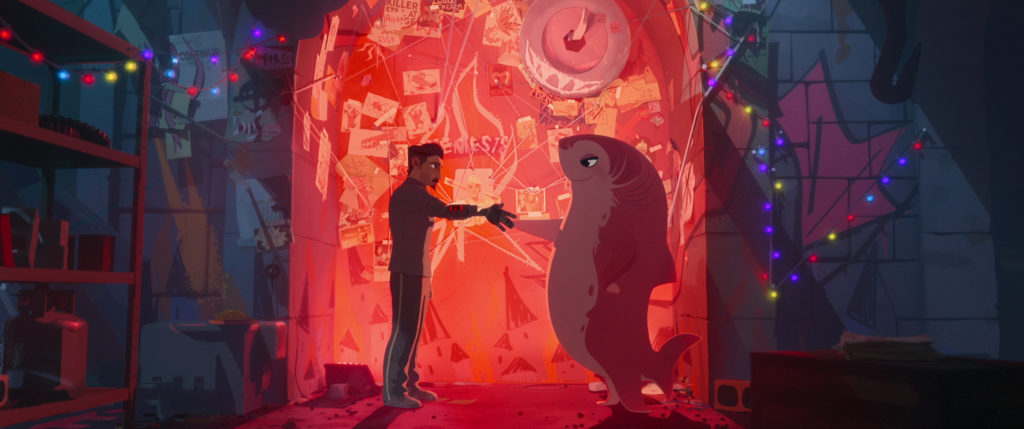Pride Music Selections: "Let It Go" and "Into the Unknown" from the 'Frozen' Franchise
From being unfairly outed, to going after the life you want for yourself, these songs from 'Frozen' perfectly capture the journey out of the closet.
Incluvie Foundation Gala - Learn More


SPOILER ALERT for Nimona (2023) dir. Troy Quane, Nick Bruno
Monster classics always lend themselves well to a queer reading because of the concept of monstrous other in cinema. Shapeshifter stories in particular can be interpreted specifically as trans allegories. This is the case for Netflix’s recent animated feature, Nimona, based on the graphic novel of the same name, created by ND Stevenson. It tells the story of the titular, Nimona, a shapeshifter who decides to help a disgraced knight reclaim his honour.
Admission to the academy for training to become a knight had previously been based on birth and class until a “commoner,” Ballister, earned himself a place in the academy by his merit and then earned Knighthood! The academy exists because many years ago, a woman named Gloreth established it to protect the citizens from monsters and it turns out that one of the so-called monster is actually Nimona herself.
Unfortunately, conspirers ensured Ballister would get disgraced by accusing him of murdering the Queen, forcing Ballister to go underground. One day, Nimona comes to him to help him get to the bottom of the mystery of who framed him. With her help, Ballister breaks into the academy and finds the information he needs. But then he’s brainwashed into questioning Nimona’s intentions, driving her away. Pushed to the brink after the betrayal from Ballister, Nimona decides to break down the city wall and attack the academy. Fortunately though, Ballister understands his mistake and apologizes, and eventually Nimona saves the city from a missile that the academy’s mentor fired on its citizens because she considered them collateral in her desire to kill Nimona.

The trans allegory in Nimona comes from the fluid identity of its titular character. Throughout the film at various points, Ballister tries to establish an identity for her and she just says she identifies as Nimona. Not as a human or a shark or a rhinoceros, but as Nimona. He keeps asking her if she’s an animal or a human or a creature and gets dismissed because she claims the questions are stupid. There’s a moment of honesty during the phase in which Nimona and Ballister are still developing their camaraderie when Nimona laments how “they only see you one way, no matter how hard you try.” This is hauntingly similar to what a gender-queer or a transgender person would say about their experience of not having their identity acknowledged when they came out.
Nimona represents the out-and-about transgender who has been ostracized by society for being different but who still believes in the strengths they derive from their identity. Even though she does take the appearance of a young girl for a majority of the time, she doesn’t hesitate to shapeshift even in full view of the entire world. She has been dismissed and hurt too many times to care. She refuses to live in the closet. Nimona’s backstory is haunting. She used to be able to shapeshift from birth, but every community she tried to join, be it the fishes or the deer, immediately treated her as alien and made her an outcast. This sequence is painful to watch and the fluid animation adds a sense of desperation to the way Nimona keeps shifting and trying to fit in.
She finally takes the form of a human girl and befriends another, who she then plays with all day. When this girl discovers Nimona’s ability to shapeshift, she loves it and they enjoy playing while Nimona keeps taking the appearance of different creatures. When the girl’s parents find out though, they immediately attack Nimona in bear form, and even manage to convince the girl, Gloreth, that Nimona is dangerous. This will unfortunately resonate with too many transgender folks. From finding friends to being rejected out of fear, queer people experience these same narrative threads much too often in their life.
Nimona even explains at one point that “I feel worse when I don’t do it.” That literally sounds like the words of a closeted person talking about how they feel when they are forced to hide their identity! In case it all still sounds like conjecture, ND Stevenson himself sees a trans allegory in Nimona. He admits he wasn’t intentionally putting the metaphors into his work when he began developing the comic, but looking back, he’s sure his feelings about his identity influenced his design of Nimona and her experiences and relationships. The best thing about Nimona is that even though she’s heartbroken and suicidal, she’s fierce and cheerful! She won’t accept mistreatment and will punish bigotry. She is a good role model for struggling trans kids and anyone struggling to find their tribe.
Related lists created by the same author
From being unfairly outed, to going after the life you want for yourself, these songs from 'Frozen' perfectly capture the journey out of the closet.
Related diversity category
Shadow & Bone excels in natural story representation with powerful centering of culture. Jessie Mei Li stars as Alina Starkov, the feisty cartographer with kindness, innocence, and integrity, who comes to be revealed as the legendary summoner of light.
Related movie/TV/List/Topic
On March 31st, International Trans Day of Visibility, following some COVID related delays, the trailer was finally dropped, and although Taylour Paige and Riley Keough look to impress as lead characters Zola and Stefani, a brief cameo from a queer icon was what convinced me I have to see this movie.